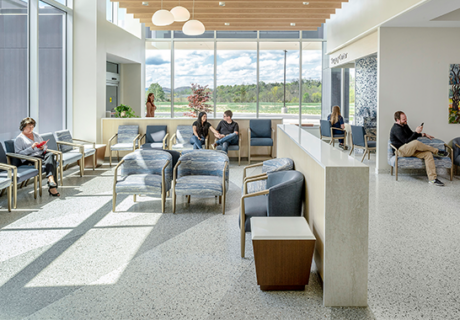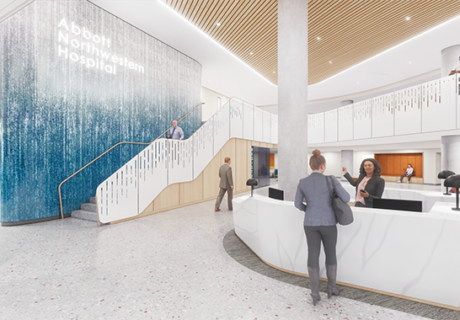Brooklyn Health Center: At Your Service
When the New York Hotel Trades Council, a union for hotel and gaming workers in New York and Northern New Jersey, outgrew its health center in Brooklyn, N.Y., and decided to build its members a replacement facility, two goals were at the forefront. First, the association wanted to create a strong image in downtown Brooklyn to fit in with an emerging neighborhood. “This site was right in the middle of the Brooklyn cultural area, and new, modern-designed buildings were going up all around it as part of a rebirth,” says Catherine Gow, principal, health facilities planning at Francis Cauffman (Philadelphia), the firm that led the design on the project. “They wanted this building to complement that new image.”
The second goal was to build a member-centered environment with high-quality, efficient care that mirrors what’s delivered in commercial healthcare facilities and with enough space to support growing demand (the replacement is three times the size of the previous site), says Dr. Robert H. Greenspan, CEO of the New York Hotel Trades Council & Hotel Association of New York City Employee Benefit Funds. The health center is part of a union contract that provides free healthcare for union members. “Members of the health center are union hotel workers who work in beautiful places every day in Manhattan, Brooklyn, etc. We wanted to do them justice [by providing a beautiful facility],” Gow says.
The owner’s initial plans called for developing a five-story, 123,000-square-foot building. However, the Francis Cauffman team saw greater potential when it reviewed the site and proposed building leasable square footage that would eventually pay for the $126 million project entirely. Specifically, by adding a privately owned public space (POPS) by way of a 2,000-square-foot park on the east side of the building that would be built for public use and maintained by the owner, the project could increase the allowable square footage. POPS such as this one are created through New York City’s incentive zoning program, which encourages private developers to provide public space within or outside their buildings by allowing them more buildable area in high-density areas. The addition of the POPS meant leasable floors could be built, creating a revenue stream to pay for the project.
The resulting 164,000-square-foot, 11-story building houses four floors belonging to the Brooklyn Health Center, six floors of leasable office and retail space, and a basement. To date, Brooklyn Hospital has leased the upper floors of the building but hasn’t yet developed the space, while the retail space on the first floor still requires tenants.
Health at the heart
Due to the location in Brooklyn that’s home to parks, theaters, and music venues, the design team strove to create a distinctive design fitting of its surroundings. “When looking at the building, we knew we wanted bright, open, transparent glass,” Gow says. “We wanted to have a building that would be unique but fit into the cultural district.”
However, because the project became a mixed-use development, Gow says the owner also wanted to make sure the Brooklyn Health Center wouldn’t get lost and, instead, would be the heart of the building. Searching for a design solution, Kasia Zielonka, lead designer at Francis Cauffman, had an epiphany when she crumpled a red piece of paper into a glass: The health center could use a bright red, curving form that would be visible through the glass façade, allowing passersby to easily see it from any vantage.
The building’s glass curtain wall contrasts with a wave-like pattern of frit and metal fins in a vertical arrangement. “The fins work to shape the building and provide a different look depending on the angle of the sun,” Gow says. “The design (of the façade) works toward the fluidity of the health center.”
The building’s façade also leverages the unique site. “The triangular site was a challenge, but we knew that this could yield a design that was interesting, and our design team took full advantage of every available inch,” Gow says. For example, an onstage/offstage model was used with a circulation spine on the left side of the building for the public and one on the right side for staff, and exam pods programmed between them.
No waiting (rooms)
The building’s fluidity moves from the exterior to the interior of the health center, which Greenspan says was designed to take full advantage of a collaborative team approach. Traditional waiting rooms are nowhere in sight. Instead, patients are greeted in the lobby, in what looks like an Apple store, where they are assigned an exam room and given a “Patient Care Connector” device that alerts the care team of their arrival. “Patients no longer move throughout the building accessing the various services they need. Rather, those services are centrally located within a pod of 10 treatment rooms,” he says.
The pods are organized by a member’s visit type, including musculoskeletal, diabetes/endocrine, cardiovascular, pediatrics/family/women, ophthalmology, dental, and procedural—not around individual physician practices. The move allows for less waiting and more fluidity between specialists. “We wanted to tie in another goal the client had, which was to get patients in and out in under an hour. This is not a small feat,” Gow says, adding that the pod layout also helps with wayfinding.
For example, exam rooms within the pods are angled, which Gow says accomplishes two things. First, when patients turn toward the corridor they can easily see the room numbers on the angled walls. Second, the angling allowed the design team to add a bench seat outside the rooms for family members or caregivers to wait when they’re asked to step outside rather than walking back to the family waiting area at the end of the hall.
Greenspan says the health center, which opened in November 2017, has exceeded all expectations, especially when it came to the original goal of upping efficiency. “In the new collaborative model, doctors are 30 percent more productive than in our existing model, yet ‘feel’ like they are working less hard,” he says.
Alicia Hoisington is a freelance writer based in Cleveland. She can be reached at hoisington.freelance@gmail.com.














